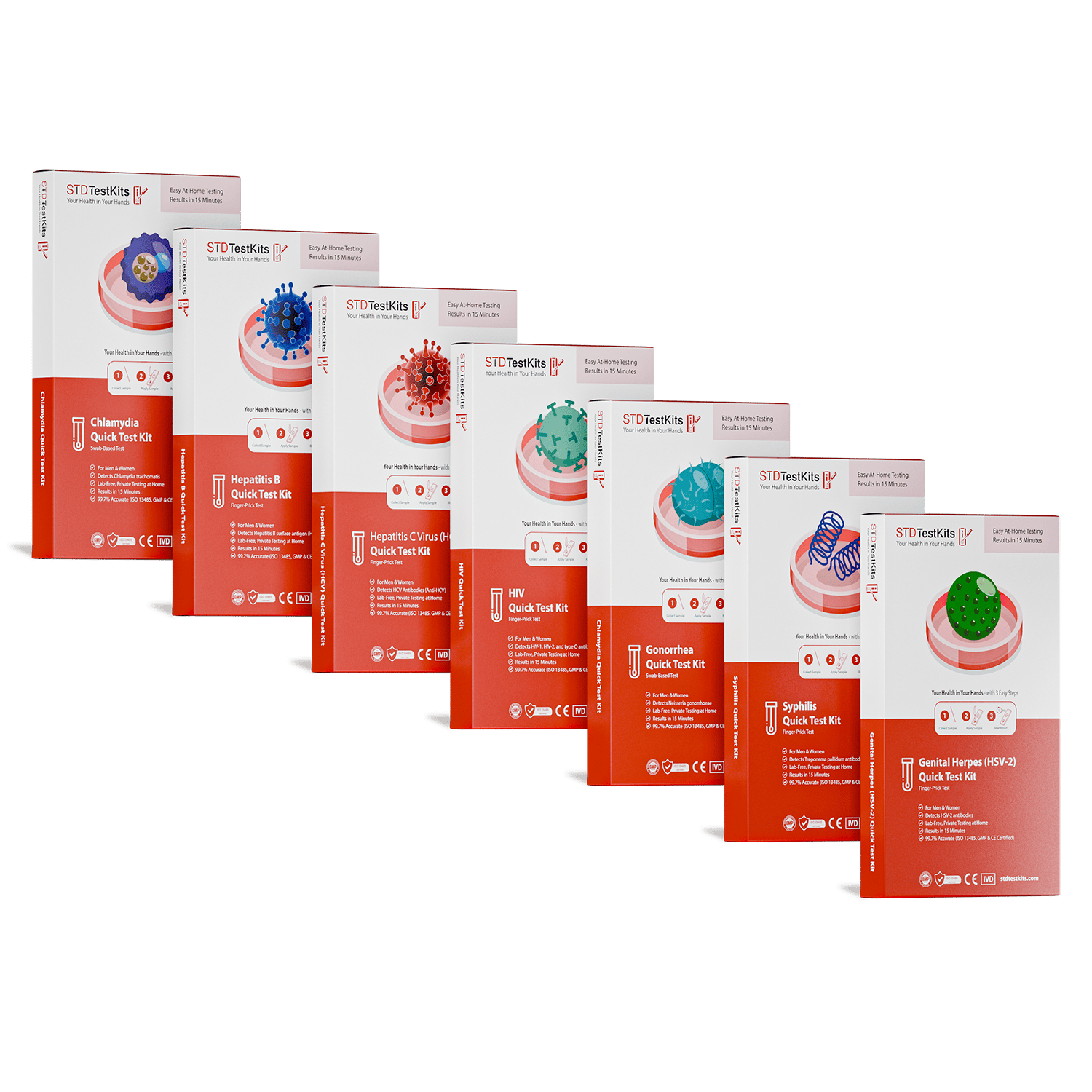How Accurate Are Chlamydia At Home Tests?
Quick Answer: A faint line on your at-home STD test doesn’t always mean positive or negative, it may be inconclusive. Retest in 7–14 days, especially if symptoms are present or timing was early. Always confirm strong positives in a clinical setting.
A Late Night Panic
Rosa flicked on her phone flashlight and leaned over her bathroom counter, the rapid STD cassette in her fingers shaking slightly. A control line was clearly there. But the second line, so faint it might’ve been a smudge, hovered in the grey zone. Is that a positive? she thought, swallowing a dry swallow.
Her mind raced:
“I always used condoms, except that one time… Did I misread it? Should I call someone?”
Within minutes, she googled “faint line STD test meaning,” “false negative STD results,” and “when to retest after exposure.” She wasn’t alone, thousands of people find themselves here every year.
Let’s walk through what comes next: the science, the surprises, what’s reliable, and the roadmap forward.

People are also reading: Syphilis Exposure Timeline: What Happens in the First 30 Days
Why Tests Sometimes Lie: The Science Behind the Lines
No medical test is perfect. At‑home rapid tests especially balance speed and convenience against technical limitations. Two key measures define how trustworthy a test is:
Sensitivity refers to how good the test is at detecting an infection when it’s actually present (avoiding false negatives). Specificity reflects how accurately it rules out infection when it’s not present (avoiding false positives).
Even the best test can sometimes miss infections. Rapid and self-collected tests, while private and fast, carry some risk of false negatives or unclear results. One 2024 study found that self-collected samples showed slightly lower sensitivity compared to clinician-collected ones, especially for chlamydia and gonorrhea.
In many at-home kits, the instructions include a caution: Testing too early or collecting an inadequate sample can lead to inaccurate results. This isn’t fearmongering. It’s science, and your body’s biology plays a role too.
The Symptom‑First Hook: When You Feel Something
If you're reading this now, you may already have symptoms. Maybe it’s a tingling burn after peeing, or a rash you noticed the morning after a hookup. You could be dealing with discharge, swollen glands, or a strange sore you’ve never seen before.
Those sensations pull you in, and they should. But symptoms alone don’t always align with accurate results, especially if the timing is off. Every STD has a different window period, the time between exposure and when a test can detect the infection. There’s also the incubation period, which is when symptoms first appear. They’re not always the same.
Figure 1: Typical window periods and symptom onset timelines for common STDs. These vary by individual and test method.
If you tested the day after a risky encounter, even the best test may not catch a developing infection. False negatives happen not because the test is faulty, but because your body hasn’t produced enough markers for detection yet.
Reading the Lines: What Your Cassette Might Be Saying
At-home STD tests are often built on lateral flow technology, similar to a pregnancy test or COVID rapid test. You’ll typically see a window marked with a C for “control” and a T for “test.” The control line confirms the test is working. The test line shows whether the target STD antigen or antibody is present.
This is where things start to get hard: What do you do when you can barely see that test line? Is it a mistake, a good result, or just noise in the background?
Figure 2: Interpreting rapid STD test line patterns. Faint lines within the reading window require careful follow-up.
Many people mistake faint lines as a “maybe.” Some ignore them; others panic. In reality, a faint line could mean:
- Early infection where the viral or bacterial load is just crossing the detection threshold.
- Degraded reagents or improperly stored tests, causing weak chemical reactions.
- Cross-reactivity or nonspecific signal, especially if the test sits past its reading window.
That’s why most manufacturers instruct you to read results within a set time window (e.g., 15 minutes), not before, and definitely not after. A test cassette left on the counter for an hour might show ghost lines that mean nothing. But a faint line within the correct timeframe? That’s a real maybe.
Why Faint or False Results Happen
So you did everything right, or at least you think you did. You opened the kit with clean hands, followed the steps like a lab tech, and set your timer to the minute. But then… the result didn’t feel clear. A shadowy line. No line at all. Something that looked suspiciously like a whisper of pink if the light hit it just right.
You’re not alone. Even when the directions are followed to the letter, rapid STD tests can sometimes give misleading results. It doesn’t mean the test is bad, or that you did something wrong. It means you’ve collided with the complicated biology of infection, detection, and human variability. Let’s unpack what could be going on behind the scenes.
Low Pathogen Load (AKA: “Too Early to Tell”)
Your body might not have made enough of what the test is looking for in the first few days after exposure, especially in the first week. Depending on the test, that could be DNA, antigens, or antibodies. It's like looking for a match in the dark: the signal is there, but the test can't see it yet.
This is a big reason why false negatives happen with infections like chlamydia, gonorrhea, and HIV. A CDC review on chlamydia screening noted that even highly sensitive tests may miss early infections if taken within days of exposure.
Micah, 22, learned this the hard way:
“I hooked up with someone new and tested five days later, negative. But two weeks later, I had pain when I peed. Retested? Positive for gonorrhea. I thought I was in the clear, but I was just early.”
Lesson? Timing is everything. A test can’t detect what your body hasn’t produced yet.
Sample Collection Issues (It Happens More Than You Think)
At-home tests depend on you to be the lab tech. That means the quality of the sample, swab, urine, or blood, is critical. A rushed swab that barely touches the area, a urine sample that’s too diluted (like after chugging a water bottle), or a drop of blood that doesn’t hit the test strip properly? All of that can result in not enough analyte reaching the test zone.
And we get it, it’s awkward. Swabbing inside your vagina or around your urethra when you're nervous? Tricky. That fingerstick lancet? Surprisingly painful for something so tiny. But the sample matters.
Nina, 34, shared this:
“The first time I tested, I barely swabbed because I was scared it would hurt. Got a faint line. Retested properly the next day, positive for trich. I think I just didn’t collect enough the first time.”
Follow the kit instructions exactly, even if it feels weird. Your accuracy depends on it.
Individual Variation (Your Body Doesn’t Follow a Script)
Every person’s immune system is unique. Some people produce antibodies quickly. Others take weeks. That’s especially true for infections like herpes or HIV, where antibody levels may rise slower than expected, or where seroconversion timelines vary wildly between individuals.
If you’re immunocompromised, recently ill, under stress, or pregnant, your body’s response could be different than what the manufacturer expects. Tests are designed around the “average” person, but there’s no such thing as average when it comes to immune systems.
That’s why retesting later can often produce different results. It’s not inconsistency, it’s your biology catching up.
Storage Conditions (Spoiler: The Backseat of Your Car Is Not a Lab)
Let’s talk about test integrity. If your kit sat in a mailbox in 100°F weather, was left in a backpack near a heater, or stored in your bathroom with the shower running daily? The test reagents could degrade.
Many rapid test kits rely on temperature-sensitive components like enzyme-coated antibodies. Heat, humidity, or even freezing conditions can make the chemicals unstable or inactive, which in turn can create faint, ghost, or missing lines, even on a clean sample.
Always store your kit as instructed (usually room temp, dry, dark place). And don’t use expired kits, even if the packaging looks fine.
Reading Errors (Too Soon, Too Late, or Overanalyzing?)
You’re supposed to read most rapid STD tests within a precise time frame, often between 10 and 20 minutes. Too early, and the test line hasn’t developed yet. Too late, and faint lines can appear that have nothing to do with infection. It’s called “evaporation shadowing,” and it can drive you insane at 2AM under a bathroom light.
Tip: Set a timer, and read your result once, within the designated window. Don’t come back 45 minutes later squinting with a flashlight. That’s how you end up interpreting ghost lines that shouldn’t count.
Dylan, 29, laughed when they said,
“I stared at the cassette for an hour like it was a Ouija board. I swear I saw a line, then I didn’t. Turns out I read it 40 minutes too late.”
Read once, read on time, and take a picture if you’re unsure, just don’t play line roulette.
Cross-Reactivity (When Other Stuff Triggers the Wrong Signal)
Sometimes, your test line isn’t from the STD you’re checking for. Instead, it might be a reaction to something your immune system is doing for other reasons, like a recent cold, vaccination, autoimmune flare, or even contamination.
This is called cross-reactivity. It’s rare, but possible, especially in antibody-based tests (like those for syphilis or HIV) that might bind to other circulating proteins in your blood.
That’s why most positive rapid tests, especially if unexpected, should be followed by a confirmatory lab test. The second test will use different technology (PCR, NAAT, etc.) and help rule out false positives.
When to Trust a Result , And When to Question It
So you tested. You saw a line, or didn’t. Now you’re stuck between relief and worry. When can you actually trust what you’re seeing?
If your control line is strong, and your test line is completely absent, and you tested after the window period, your result is likely reliable, especially if you have no symptoms and no new exposure.
But if your symptoms are present, your test was done less than 10 days after exposure, or your test line was faint or unclear, it’s safer to consider the result provisional. Not wrong, but not final.
That’s where retesting comes in. Not because you failed, but because biology is complex, and timing is everything.

People are also reading: Think HPV Isn’t a Men’s Issue? Think Again
When to Retest: Timing Matters More Than You Think
If your test result is unclear, or if it’s negative but your symptoms keep shouting something’s off, don’t assume you’re done. Retesting isn't about being paranoid; it's about giving your body enough time to produce detectable signals.
Most experts recommend retesting in two phases:
- Phase 1: This happens about 7 to 14 days after the first exposure or an unclear result. This includes failures to find things early.
- Phase 2: About three months after possible exposure (especially for HIV, syphilis, and herpes) when tests that look for antibodies are more accurate.
Here’s how these retesting windows might play out depending on your situation:
Figure 3: Suggested retesting windows based on test results, exposure, and symptoms. Time protects accuracy.
And let’s be real, many people don’t test just once. Whether it’s anxiety, a new hookup, or just needing that extra peace of mind, repeat testing is common. You’re not being irrational. You’re being cautious, and smart.
Moving From Uncertainty to Prevention
You have tested. Possibly more than once. You know how a faint line can make you feel. So what's next isn't just about finding things; it's also about keeping them safe. Because everything you do after a test, good or bad, affects your risk and confidence in the future.
Here’s what we know from the data:
- Barrier use matters. Condoms reduce the risk of chlamydia, gonorrhea, and HIV significantly, but they don’t cover everything, like skin-to-skin spread of herpes or HPV.
- Vaccines exist for Hepatitis B and HPV. If you haven’t been vaccinated, ask your provider or local clinic how to access them affordably.
- Talk to partners. Disclosure is hard, but it’s also powerful. Whether you’re newly diagnosed or just want to prevent surprises, honest communication protects everyone involved.
- Don’t delay treatment. Most bacterial STDs, like chlamydia, gonorrhea, and syphilis, are curable with antibiotics. The sooner you’re treated, the less likely you are to face complications, or to pass it to someone else unknowingly.
- Retest after treatment. Just because you took meds doesn’t mean you’re in the clear forever. Some providers recommend a “test of cure” 3–4 weeks after finishing treatment to ensure eradication, especially for chlamydia.
And remember, there’s no shame in testing often. Regular testing is care. It’s a way of saying: I respect myself. I respect others. I want clarity, not silence.
FAQs
1. I followed the instructions, but the test line was barely there. Am I positive or not?
If the test line showed up during the official read window (usually within 15 minutes), even if it was very faint, it could mean something is wrong. It could be an early-stage infection or a result that is on the edge. Don't freak out, but don't ignore it either. If you can, retest in 7 to 14 days or get a lab confirmation. You deserve to know for sure, not to be confused.
2. Can I still have an STD even if my at-home test was negative?
Yep. Especially if you tested too early. Most STDs have a “window period”, basically a lag between when you’re exposed and when a test can pick it up. It’s like trying to catch a whisper in a hurricane: possible, but tough. If your symptoms stick around or your gut says “something’s off,” retest or go to a clinic. Trust your body.
3. How accurate are these home kits, really?
When used properly and at the right time? Surprisingly solid. Many use similar tech as clinic tests, just packed in a privacy-friendly box. But there’s room for user error (bad swab, wrong timing), so don’t treat them like absolute truth. Think of them as your first line of clarity, not the final word.
4. What do I do if my test says positive and I wasn’t expecting it?
First, take a breath. We’ve seen people spiral over results they misunderstood or mistimed. If it’s a strong positive, you should definitely get a confirmatory test. Many STDs are treatable (and curable). The real danger isn’t the result, it’s silence, shame, or inaction. You’re already doing the hard part by testing. Keep going.
5. Is it bad to test again just a few days later?
Not bad, just… not super helpful. If your body hasn’t had time to build up enough detectable stuff (antibodies, antigens, DNA), your second test might just tell you the same “meh” thing. Give it a week or two. Accuracy gets better with time. Let your immune system do its thing.
6. Why is there a line at all if I feel totally fine?
A lot of STDs are sneaky. Chlamydia, for instance, is called “the silent infection” for a reason, most people never get a single symptom. So don’t rely on how you feel to gauge your status. Your body isn’t always loud about these things. That’s why routine testing exists.
7. Do I need to tell my partner even if I’m not 100% sure yet?
If you’re in the “faint line” zone or waiting on confirmation, it’s okay to say: “Hey, I’m in the middle of getting this figured out, I just wanted you to know.” You don’t need all the answers to open that door. Good partners appreciate honesty, not perfection.
8. What’s the deal with retesting after treatment?
Think of it like checking your work. For some infections (like chlamydia), guidelines recommend a “test of cure” around 3–4 weeks after antibiotics. It’s not about doubt, it’s about being sure your body got the message and cleared things out. Also, it helps prevent passing it back and forth like a bad game of ping-pong.
9. Should I be embarrassed about testing often?
Hell no. Testing isn’t a confession, it’s care. It’s curiosity. It’s making sure you (and anyone you’re intimate with) are safe. You wouldn’t feel weird about checking your tire pressure or seeing your dentist. This is the same, just a little more intimate.
10. Where can I find a test I can trust?
You’re in the right place. STD Test Kits offers discreet, fast, and doctor-trusted kits, delivered without judgment or fuss. Whether you’re checking symptoms or just want peace of mind, there’s a test kit that fits your life.
Your Next Step Is Power, Not Panic
That line, faint or strong, present or absent, is just a moment. What matters more is what you do next. Will you give yourself the gift of certainty? Will you talk to your partners, your provider, your own body?
At-home STD tests are powerful tools, but they’re not the final word. Use them wisely. Read carefully. Retest when needed. And above all, treat each result not as a verdict, but as a step toward clarity, confidence, and care.
Don’t wait and wonder.
How We Sourced This Article: We combined current guidance from leading medical organizations with peer-reviewed research and lived-experience reporting to make this guide practical, compassionate, and accurate. In total, around fifteen references informed the writing; below, we’ve highlighted some of the most relevant and reader-friendly sources.
Sources
1. Screening for Chlamydial and Gonococcal Infections – NCBI
2. Meta-analysis on self-collected STD samples – Nature (2024)
3. STI Symptoms and Testing – SmartSexResource.com
4. STD Testing Window Periods – VeryWell Health
5. What to Know About At-Home STD Tests | WebMD
6. Testing for STIs at Home — American Sexual Health Association
About the Author
Dr. F. David, MD is a board-certified infectious disease specialist focused on STI prevention, diagnosis, and treatment. He blends clinical precision with a no-nonsense, sex-positive approach and is committed to expanding access for readers in both urban and off-grid settings.
Reviewed by: L. Bianchi, NP-C | Last medically reviewed: September 2025
This article is for informational purposes and does not replace medical advice.







